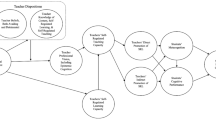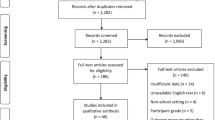Abstract
The present study assessed the associations among higher-order thinking skills (reflective thinking, critical thinking) and self-monitoring that contribute to academic achievement among university students. The sample consisted of 196 Iranian university students (mean age = 22.05, SD = 3.06; 112 females; 75 males) who were administered three questionnaires. To gauge reflective thinking, the “Reflective Thinking Questionnaire” designed by Kember et al. (Assess Eval High Educ 25(4):380–395, 2000) was utilized. It includes 16 items measuring four types of reflective thinking (habitual action, understanding, reflection, and critical reflection). To assess critical thinking, the “Watson–Glaser Critical Thinking Appraisal”(2002) was utilized. It comprises 80 items and consists of 5 subtests (inference, recognizing unstated assumptions, deduction, interpretation, and evaluation). Self-monitoring was measured via 8 items of the self-regulation trait questionnaire designed by O’Neil and Herl (Paper presented at the annual meeting of the American Educational Research Association, San Diego, CA, 1998). The results demonstrated that critical thinking and all components of reflective thinking positively and significantly predicted achievement with habitual action having the lowest impact and reflection exhibiting the highest influence. Self-monitoring indirectly exerted a positive influence on achievement via understanding and reflection. It was also found that among the four subscales of reflective thinking, reflection and critical reflection predicted critical thinking positively and significantly. Self-monitoring had a positive and significant impact on critical thinking. It also significantly and positively influenced understanding as well as reflection.

Similar content being viewed by others
References
Bourdillon, H., & Storey, A. (2002). Aspects of teaching and learning in secondary schools: Perspectives on practice. London: RoutledgeFalmer.
Choy, S., & Cheah, P. (2009). Teacher perceptions of critical thinking among students and its influence on higher education. International Journal of Teaching and Learning in Higher Education, 20(2), 198–206.
Davidson, B. W., & Dunham, R. (1997). Assessing EFL student progress in critical thinking with the Ennis-Weir critical thinking essay test. JALT Journal, 19(1), 43–57.
Day, C. (2000). Effective leadership and reflective practice. Reflective Practice, 1, 113–127.
Dewey, J. (1933). How we think. Chicago: Henry Regnery.
Elder, L., & Paul, R. (2004). Critical thinking and the art of close reading (part IV). Journal of Developmental Education, 28(2), 36–37.
Facione, N. C., & Facione, P. A. (1996). Externalizing the critical thinking in knowledge development and critical judgment. Nursing Outlook, 44(3), 129–136.
Ghanizadeh, A. (2011). An investigation into the relationship between self-regulation and critical thinking among Iranian EFL teachers. The Journal of Technology & Education, 5(3), 213–221.
Ghanizadeh, A., & Ghonsooly, B. (2014). A tripartite model of EFL teacher attributions, burnout, and self-regulation: toward the prospects of effective teaching. Educational Research in Policy and Practice, 13, 145–166. doi:10.1007/s10671-013-9155-3.
Ghanizadeh, A., & Mirzaee, S. (2012a). EFL learners’ self-regulation, critical thinking and language achievement. International Journal of Linguistics, 4(3), 444–461.
Ghanizadeh, A., & Mirzaee, S. (2012b). Critical thinking: How to enhance it in language classes. Germany: LAP.
Ghonsooly, B., & Ghanizadeh, A. (2013). Self-efficacy and self-regulation and their relationship: A study of Iranian EFL teachers. The Language Learning Journal, 41(1), 68–84. doi:10.1080/09571736.2011.625096.
Halpern, D. F. (2007). Halpern critical thinking assessment using everyday situations: Background and scoring standards. Claremont, CA: Claremont McKenna College.
Hashemi, M. R., & Ghanizadeh, A. (2012). Critical discourse analysis and critical thinking: An experimental study in an EFL context. System, 40(1), 37–47.
Henderson-Hurley, M., & Hurley, D. (2013). Enhancing critical thinking skills among authoritarian students. International Journal of Teaching and Learning in Higher Education, 25(2), 248–261. doi:10.1080/10511250300085841.
Herl, H. E., O’Neil, H. F., Chung, G. K. W. K., Bianchi, C., Wang, S. L., Mayer, R., Lee, C. Y., Choi, A., Suen, T., & Tu, A. (1999, March). Final report for validation of problem- solving measures. CSE Technical Report 501. Los Angles: University of California.
Ivie, S. D. (2001). Metaphor: A model for teaching critical thinking. Contemporary Education, 72(1), 18–23.
Kealey, B. T., Holland, J., & Watson, M. (2005). Preliminary evidence on the association between critical thinking and performance in principles of accounting. Issues in Accounting Education, 20(1), 33–49.
Kember, D., Leung, D., Jones, A., & Loke, A. Y. (2000). Development of a questionnaire to measure the level of reflective thinking. Assessment and Evaluation in Higher Education, 25(4), 380–395.
Khodadady, E., & Ghanizadeh, A. (2011). The impact of concept mapping on EFL learners’ critical thinking ability. English Language Teaching, 4(4), 49–60.
Kraft, N. P. (2002). Teacher research as a way to engage in critical reflection: A case study. Reflective Practice, 3, 175–189.
Ku, K. Y. L. (2009). Assessing students’ critical thinking performance: Urging for measurements using multi-response format. Thinking Skills and Creativity, 4, 70–76.
Kuiper, R. (2002). Enhancing metacognition through the reflective use of self-regulated learning strategies. The Journal of Continuing Education in Nursing, 33(2), 78–87.
Lee, S. K. F., & Loughran, J. (2000). Facilitating pre-service teachers’ reflection through a school based teaching programme. Reflective Practice, 1, 69–89.
Leung, D. Y. P., & Kember, D. (2003). The relationship between approaches to learning and reflection upon practice. Educational Psychology, 23, 61–71.
Mayfield, M. (2001). Thinking for yourself: Developing critical thinking skills through reading and writing (5th ed.). London: Harcourt College.
Mezirow, J. (1998). On critical reflection. Adult Learning Quarterly, 48(3), 185–198.
Minnich, E. (1990). Transforming knowledge. Philadelphia: Temple University Press.
Monshi Toussi, M. T., & Ghanizadeh, A. (2012). A study of EFL teachers’ locus of control and self-regulation and the moderating role of self-efficacy. Theory and Practice in Language Studies, 2(11), 2363–2371.
Moon, J. (2008). Critical thinking: An exploration of theory and practice. London and New York: Routledge.
O’Neil, H. F., & Herl, H. E. (1998). Reliability and validity of a trait measure of self-regulation. In Paper presented at the annual meeting of the American Educational Research Association, San Diego, CA.
Paul, R. (1988). Critical thinking in the classroom. Teaching K-8, 18(1), 49–51.
Phan, H. P. (2006). Examination of student learning approaches, reflective thinking, and epistemological beliefs: A latent variables approach. Journal of Research in Educational Psychology, 4(3), 577–610.
Phan, H. P. (2010). Critical thinking as a self-regulatory process component in teaching and learning. Psicothema, 22(2), 284–292.
Pintrich, P. R. (1999). The role of motivation in promoting and sustaining self-regulated learning. International Journal of Educational Research, 31, 459–470.
Schneider, W. (2008). The development of metacognitive knowledge in children and adolescents: Major trends and implications for education. Mind, Brain, and Education, 2(3), 114–121.
Schön, N. D. A. (1987). Educating the reflective practitioner. San Francisco: Jossey-Bass.
Schraw, G., Crippen, K. J., & Hartley, K. (2006). Promoting self-regulation in science education: Metacognition as part of a broader perspective on learning. Research in Science Education, 36, 111–139.
Schunk, D. H., & Pajares, F. (2001). The development of self-efficacy. In A. Wigfield & J. Eccles (Eds.), Development of achievement motivation. San Diego: Academic.
Scriven, M., & Paul, R. (2004). Defining Critical Thinking. Retrieved September 2008. http://www.criticalthinking.org/aboutCT/definingCT.shtml.
Smith, V. G., & Szymanski, A. (2013). Critical thinking: More than test scores. International Journal of Educational Leadership Preparation, 8(2), 15–24.
Tuncer, M., & Ozeren, E. (2012). Prospective Teacher’s evaluations in terms of using reflective thinking skills to solve problems. Procedia-Social and Behavioral Sciences, 51, 666–671.
Watson, G. B., & Glaser, E. M. (2002). Watson–Glaser critical thinking appraisal. London: The Psychological Corporation.
Zeidner, M., Boekaerts, M., & Pintrich, P. R. (2000). Self-regulation: directions and challenges for future research. In M. Boekaerts, P. R. Pintrich, & M. Zeidner (Eds.), Handbook of self-regulation (pp. 749–768). San Diego, CA: Academic.
Zimmerman, B. J. (2000). Attaining self-regulation: A social cognitive perspective. In M. Boekaerts, P. R. Pintrich, & M. Zeidner (Eds.), Handbook of self-regulation (pp. 13–39). San Diego, CA: Academic.
Zimmerman, B. J., Bonner, S., & Kovach, R. (1996). Developing self-regulated learners: Beyond achievement to self-efficacy. Washington DC: American Psychological Association.
Author information
Authors and Affiliations
Corresponding author
Rights and permissions
About this article
Cite this article
Ghanizadeh, A. The interplay between reflective thinking, critical thinking, self-monitoring, and academic achievement in higher education. High Educ 74, 101–114 (2017). https://doi.org/10.1007/s10734-016-0031-y
Published:
Issue Date:
DOI: https://doi.org/10.1007/s10734-016-0031-y




